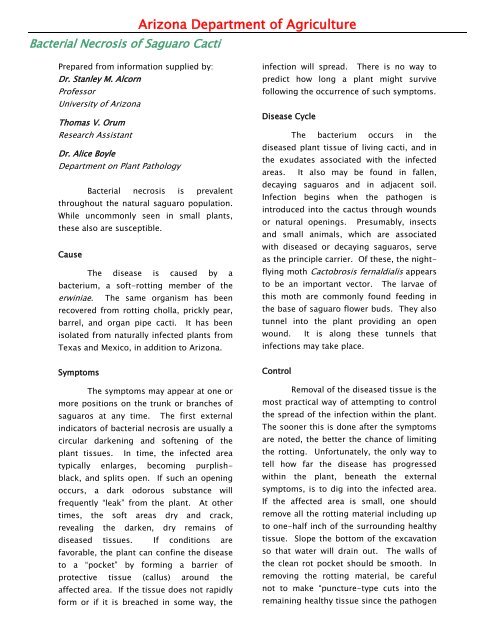Bacterial Necrosis of Saguaro - Arizona Department of Agriculture
Bacterial Necrosis of Saguaro - Arizona Department of Agriculture
Bacterial Necrosis of Saguaro - Arizona Department of Agriculture
Create successful ePaper yourself
Turn your PDF publications into a flip-book with our unique Google optimized e-Paper software.
<strong>Bacterial</strong> <strong>Necrosis</strong> <strong>of</strong> <strong>Saguaro</strong> Cacti<br />
Prepared from information supplied by:<br />
Dr. Stanley M. Alcorn<br />
Pr<strong>of</strong>essor<br />
University <strong>of</strong> <strong>Arizona</strong><br />
Thomas V. Orum<br />
Research Assistant<br />
Dr. Alice Boyle<br />
<strong>Department</strong> on Plant Pathology<br />
<strong>Arizona</strong> <strong>Department</strong> <strong>of</strong> <strong>Agriculture</strong><br />
<strong>Bacterial</strong> necrosis is prevalent<br />
throughout the natural saguaro population.<br />
While uncommonly seen in small plants,<br />
these also are susceptible.<br />
Cause<br />
The disease is caused by a<br />
bacterium, a s<strong>of</strong>t-rotting member <strong>of</strong> the<br />
erwiniae. The same organism has been<br />
recovered from rotting cholla, prickly pear,<br />
barrel, and organ pipe cacti. It has been<br />
isolated from naturally infected plants from<br />
Texas and Mexico, in addition to <strong>Arizona</strong>.<br />
Symptoms<br />
The symptoms may appear at one or<br />
more positions on the trunk or branches <strong>of</strong><br />
saguaros at any time. The first external<br />
indicators <strong>of</strong> bacterial necrosis are usually a<br />
circular darkening and s<strong>of</strong>tening <strong>of</strong> the<br />
plant tissues. In time, the infected area<br />
typically enlarges, becoming purplish-<br />
black, and splits open. If such an opening<br />
occurs, a dark odorous substance will<br />
frequently “leak” from the plant. At other<br />
times, the s<strong>of</strong>t areas dry and crack,<br />
revealing the darken, dry remains <strong>of</strong><br />
diseased tissues. If conditions are<br />
favorable, the plant can confine the disease<br />
to a “pocket” by forming a barrier <strong>of</strong><br />
protective tissue (callus) around the<br />
affected area. If the tissue does not rapidly<br />
form or if it is breached in some way, the<br />
infection will spread. There is no way to<br />
predict how long a plant might survive<br />
following the occurrence <strong>of</strong> such symptoms.<br />
Disease Cycle<br />
The bacterium occurs in the<br />
diseased plant tissue <strong>of</strong> living cacti, and in<br />
the exudates associated with the infected<br />
areas. It also may be found in fallen,<br />
decaying saguaros and in adjacent soil.<br />
Infection begins when the pathogen is<br />
introduced into the cactus through wounds<br />
or natural openings. Presumably, insects<br />
and small animals, which are associated<br />
with diseased or decaying saguaros, serve<br />
as the principle carrier. Of these, the night-<br />
flying moth Cactobrosis fernaldialis appears<br />
to be an important vector. The larvae <strong>of</strong><br />
this moth are commonly found feeding in<br />
the base <strong>of</strong> saguaro flower buds. They also<br />
tunnel into the plant providing an open<br />
wound. It is along these tunnels that<br />
infections may take place.<br />
Control<br />
Removal <strong>of</strong> the diseased tissue is the<br />
most practical way <strong>of</strong> attempting to control<br />
the spread <strong>of</strong> the infection within the plant.<br />
The sooner this is done after the symptoms<br />
are noted, the better the chance <strong>of</strong> limiting<br />
the rotting. Unfortunately, the only way to<br />
tell how far the disease has progressed<br />
within the plant, beneath the external<br />
symptoms, is to dig into the infected area.<br />
If the affected area is small, one should<br />
remove all the rotting material including up<br />
to one-half inch <strong>of</strong> the surrounding healthy<br />
tissue. Slope the bottom <strong>of</strong> the excavation<br />
so that water will drain out. The walls <strong>of</strong><br />
the clean rot pocket should be smooth. In<br />
removing the rotting material, be careful<br />
not to make “puncture-type cuts into the<br />
remaining healthy tissue since the pathogen
can survive in such sites. Thoroughly wash<br />
the cleansed pocket with 10% household<br />
bleach solution (e.g., 1 part Clorox and 9<br />
parts <strong>of</strong> water; also include one teaspoon <strong>of</strong><br />
liquid detergent per gallon <strong>of</strong> solution) and<br />
then allow the pocket to stand open to<br />
hasten healing.<br />
If the lesion is located such the described<br />
treatment is not practical or if it is so large<br />
to nearly girdle or weaken an arm or plant,<br />
serious consideration should be given to<br />
removal <strong>of</strong> the affected structure.<br />
Otherwise, damage might result should the<br />
branch or plant unexpectedly fall.<br />
A Broader Perspective<br />
While the landowner is justifiably<br />
saddened by the loss <strong>of</strong> a giant saguaro, it<br />
may be <strong>of</strong> some consolation to view the rot<br />
as a natural part <strong>of</strong> the desert environment.<br />
The active rot pocket is a wet spot in a dry<br />
place, and there is a raft <strong>of</strong> desert dwellers,<br />
including insects, fungi, nematodes, and<br />
others, that depend on it for moisture and<br />
nutrients. In addition, calloused-over dry-<br />
rot pockets in surviving saguaros can <strong>of</strong>fer<br />
places <strong>of</strong> respite for larger animals.<br />
However, much still remains to be learned<br />
about the role <strong>of</strong> s<strong>of</strong>t-rot <strong>of</strong> saguaros and<br />
other cacti in our Southwestern desert<br />
ecosystem.



